Joint Mobility Exercises for Stronger Muscles and Functional Flexibility
Joint mobility exercises hold the key to unlocking the pain-free movement you thought was lost forever—and your body is ready to respond faster than you imagine. Your joints tell the story of how you’ve been moving—or not moving—throughout your life. Every stiff shoulder rotation, every tight hip when climbing stairs, every creaky knee that hesitates before bending reveals joints crying out for attention they haven’t received. While most fitness culture obsesses over building muscle mass or cardiovascular endurance, joint mobility determines your actual quality of life—your ability to play with grandchildren, garden without back pain, or simply turn your head to check blind spots while driving.
This comprehensive guide reveals why mobility training surpasses simple stretching, introduces you to functional flexibility exercises that work with your body’s natural design, and provides a complete daily routine requiring just 10-15 minutes. You’ll discover specific movements targeting every major joint, understand the science behind why these exercises work, and learn exactly how to build lasting flexibility that transforms how your body feels from the moment you wake up.
Why Joint Mobility Matters (And Who Benefits Most)
Joint mobility represents your body’s ability to move smoothly through its full natural range of motion with control and without pain. Unlike passive flexibility—how far someone else can push your limb—mobility requires active muscular control throughout the entire movement arc. This distinction matters profoundly because mobility training strengthens the stabilizing muscles surrounding your joints while simultaneously increasing range of motion, creating sustainable improvement rather than temporary looseness that disappears within hours.
Circulation increases, inflammation decreases, and muscle coordination improves when you regularly perform joint mobility exercises. Your joints contain synovial fluid that lubricates cartilage and reduces friction, but this fluid only circulates when you move the joint through various angles. Sedentary modern life creates a vicious cycle—stiffness leads to reduced movement, which causes more stiffness, progressively limiting your range until simple tasks become challenging. Breaking this cycle doesn’t require gym memberships or equipment; it requires consistent attention to moving every major joint daily through movements your body was designed to perform.
Research demonstrates that regular mobility training significantly reduces injury risk, improves athletic performance, and alleviates chronic pain conditions. Office workers suffering from neck and shoulder tension, athletes seeking performance enhancement, older adults wanting to maintain independence, and anyone recovering from injury all benefit dramatically from functional flexibility exercises. Your nervous system also responds to mobility work—when joints move freely without restriction, your body perceives safety rather than threat, which helps calm your nervous system naturally and reduces the protective muscle tension that often perpetuates stiffness. The compound benefits extend far beyond the joints themselves into every system of your body.
Why Muscle Control Training Surpasses Simple Bulk Strength
Traditional strength training focuses primarily on how much weight you can move, often emphasizing muscle size over neuromuscular control. While building strength has value, developing precise muscular control through joint mobility exercises creates capabilities that raw strength alone cannot provide. Control means consciously directing specific muscles to contract or relax on command, moving joints independently without recruiting unnecessary muscle groups, and maintaining stability while exploring full range of motion. This sophistication of movement prevents injuries, enhances daily function, and creates the foundation upon which strength can be safely built.
When you develop control through mobility training, you’re not merely exercising muscles—you’re training your nervous system to communicate more effectively with those muscles. Every joint movement requires coordination between agonist muscles that create motion, antagonist muscles that control and moderate that motion, and stabilizer muscles that maintain proper alignment throughout. Poor control patterns often mean some muscles overwork while others remain dormant, creating imbalances that manifest as pain, injury, or movement limitation. Functional flexibility exercises systematically address these imbalances by requiring full-body coordination rather than isolated muscle contraction.
The exhilaration of achieving muscular control, the increased local strength in small stabilizing muscles often ignored in conventional training, and the enhanced general health create benefits entirely disproportionate to the minimal time investment required. Someone with exceptional control can often outperform someone with greater raw strength in real-world activities because they recruit precisely the right muscles at the right time with appropriate force.
This efficiency reduces energy expenditure, decreases wear on joints, and allows sustained activity without the exhaustion that comes from fighting against your own body’s poor movement patterns. Mobility training to improve joint mobility fundamentally changes how your neuromuscular system operates, creating capabilities that persist throughout all your daily movements rather than just during exercise.
Neck and Shoulder Control Exercises to Prevent Tension Headaches
Neck and shoulder tension represents one of the most common sources of chronic discomfort in modern life, directly causing tension headaches that plague millions daily. These headaches arise not from mysterious causes but from simple muscular fatigue—muscles forced to maintain static positions for hours while you stare at screens, drive vehicles, or perform repetitive tasks. Developing control in neck and shoulder muscles through targeted joint mobility exercises eliminates the root cause rather than merely masking symptoms with medication.
Neck Circles and Controlled Movements: Stand with your back against a wall, keeping shoulders and upper back in contact with the surface. Slowly move your head forward and backward along a vertical plane, ensuring your face remains on the same vertical line rather than tilting up or down. This seemingly simple movement requires precise control of deep neck flexors and extensors. Perform 8-10 repetitions, then practice lateral movement—sliding your head directly sideways without rolling or tilting, as if your head were moving along a horizontal track.

Initially, you’ll find the sideways movement particularly challenging; be content with small ranges and gradually increase as control develops. These movements strengthen all neck muscles while teaching them to work independently, preventing the compensatory patterns that cause fatigue and headaches.
Shoulder Rolls and Arm Circles: From standing position, perform slow, deliberate shoulder rolls—lifting shoulders toward ears, pulling them back, pressing them down, then forward to complete the circle. Reverse direction after 6-8 repetitions. Progress to arm circles by extending arms laterally to shoulder height, making small circles that gradually grow larger, engaging the entire shoulder girdle. Advanced practitioners can perform opposite rotations simultaneously—one arm circling forward while the other circles backward—which dramatically enhances neuromuscular control and coordination.
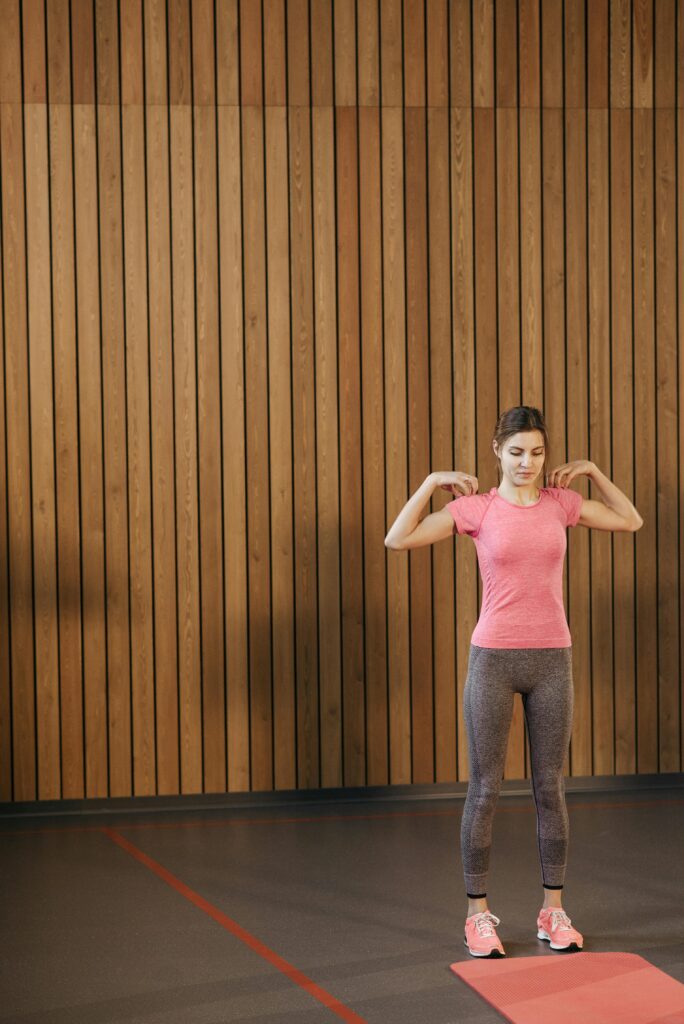

These functional flexibility exercises boost upper-body flexibility while releasing chronic tension patterns that accumulate from sitting and forward-reaching activities. The increased blood flow to shoulder tissues accelerates healing of minor strains and reduces inflammation that contributes to stiffness. Practice these movements multiple times daily, especially during work breaks, to prevent tension from accumulating rather than trying to release it after it’s already caused discomfort.
Unlock Your Hips: The Simple Pelvic Shift for Walking Ease
Hip mobility profoundly affects your entire kinetic chain—how you walk, stand, sit, and perform virtually every lower-body movement. Tight hips create compensatory patterns throughout your spine, knees, and ankles, distributing stress inappropriately and causing pain in seemingly unrelated areas. The pelvic shift exercise provides remarkable benefits despite its simplicity, directly targeting the flexibility and vigor of muscles and ligaments in the hip region while improving walking elasticity and endurance.
The Pelvic Weight Transfer: Assume correct standing posture with feet hip-width apart. Consciously relax your hip and leg muscles, allowing your full body weight to settle onto your left leg. As weight transfers, permit your right leg to bend slightly and your right hip to sag downward as far as comfortable. Hold this position for 2-3 seconds, noticing the stretch through the hip flexors and surrounding tissues. Now smoothly transfer weight to your right leg, allowing your left hip to drop loosely.

This seemingly awkward position—which would indeed be poor for static standing—provides exceptional training when practiced as dynamic movement. The exercise of transferring weight from one side of the pelvis to the other increases flexibility and muscular control in ways that dramatically improve joint mobility throughout the hip complex.
Initially, perform the pelvic shift slowly for just 1-2 minutes, focusing on smooth weight transfers and controlled hip drops. As proficiency develops, you’ll find you can drop rapidly from one hip to the other without discomfort, eventually extending practice to 4-5 minutes. This progression builds not just flexibility but muscular endurance in the stabilizing muscles that support your pelvis during walking and running. The benefits extend immediately to your gait—many practitioners report that walking feels noticeably easier and more fluid after just a few sessions.
Hip circles and leg swings complement this foundational exercise: standing on one leg, swing the other forward and backward in a controlled pendulum motion, gradually increasing range. Then perform lateral leg swings across your body. These movements open tight hip capsules while improving balance and coordination. Combined, these simple joint mobility exercises to improve joint mobility transform hip function more effectively than aggressive static stretching, which often creates temporary looseness without developing the control necessary for functional movement.
The Best Exercises for Flexibility and Control in Your Legs and Core
Lower body and core mobility create the foundation for all movement—walking, climbing, bending, lifting, and maintaining balance. While leg strength gets abundant attention in fitness culture, the control and flexibility that allow safe, efficient force application often get neglected. The following functional flexibility exercises develop comprehensive lower body capability while strengthening your core’s ability to stabilize your spine during dynamic movement.
Deep Squat Hold: This fundamental human position—which young children naturally assume but most adults have lost—rebuilds knee and hip mobility while strengthening core muscles and improving ankle flexibility. Begin by holding onto a stable surface for support. Lower yourself into the deepest squat your body currently allows, keeping heels down if possible (elevating heels slightly on a thin book is acceptable initially). Hold this position for 20-30 seconds, breathing deeply and allowing your body to gradually relax deeper into the stretch.

Your hips should sink below knee level, spine should remain relatively upright, and feet should point forward or slightly outward. Practice daily, gradually releasing support and extending hold time to several minutes. This single position addresses tight hip flexors, restricted ankle dorsiflexion, weak core stabilizers, and limited thoracic spine mobility—making it perhaps the most efficient joint mobility exercise for comprehensive lower body development.
Cat-Cow Stretch and Thoracic Twists: Position yourself on hands and knees with a neutral spine. Exhale while rounding your spine upward like a frightened cat, tucking your tailbone and dropping your head. Inhale while reversing the curve—lifting your chest and tailbone toward the ceiling while allowing your belly to drop. This rhythmic spinal flexion and extension improves spine mobility and activates deep stabilizing muscles that protect against back pain. Perform 8-12 cycles with smooth, controlled movements synchronized with breathing.
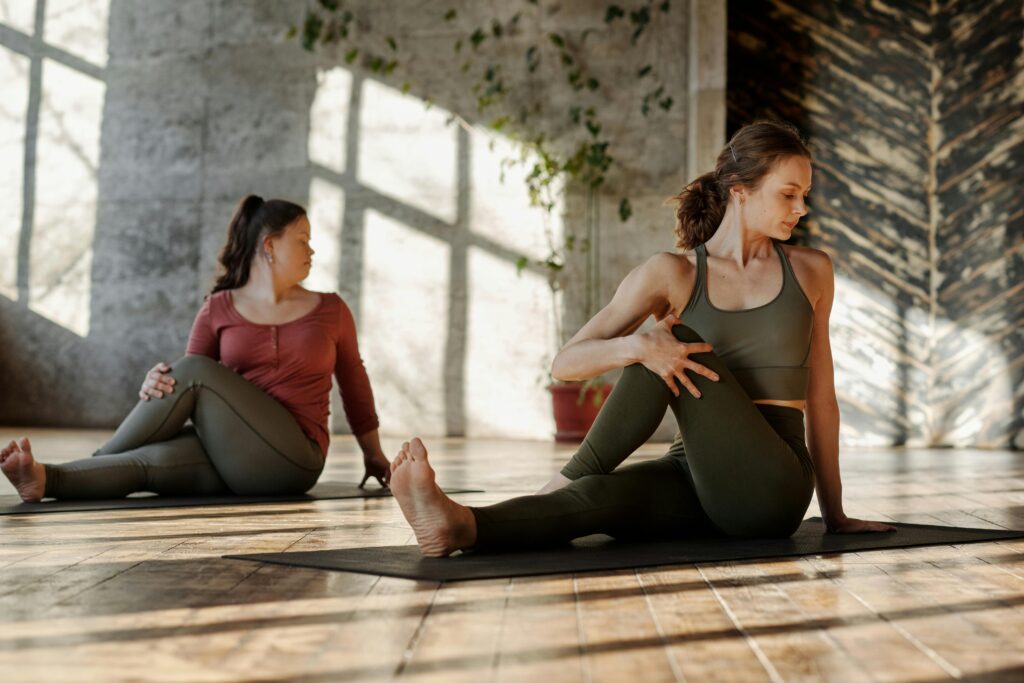
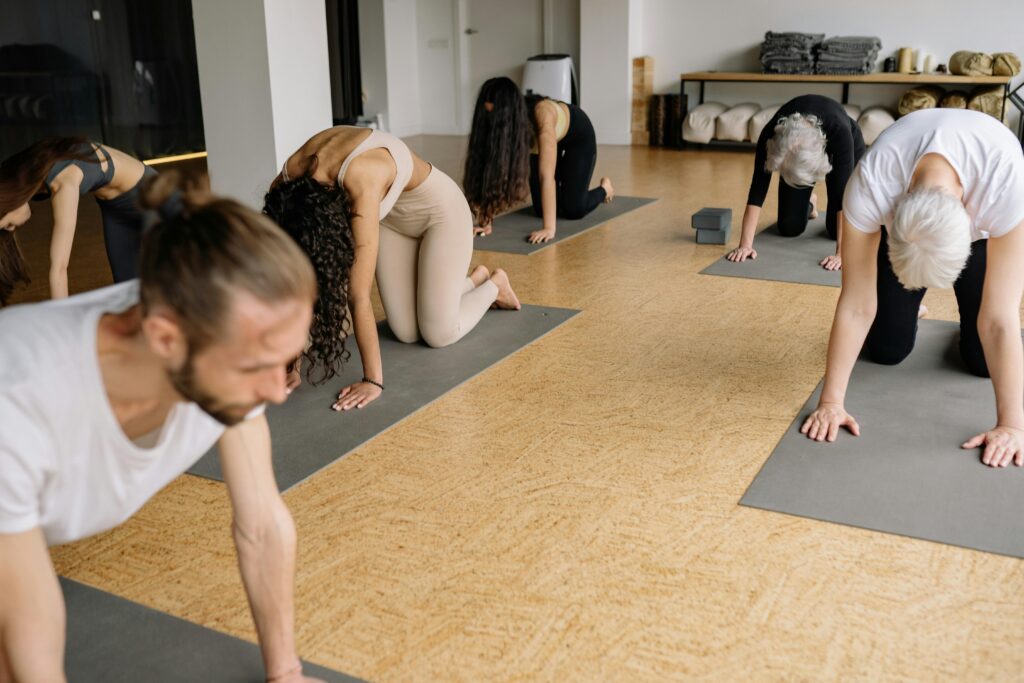
Progress to thoracic twists: from the same hands-and-knees position, place your right hand behind your head. Rotate your torso, bringing right elbow toward the floor, then opening it toward the ceiling while following with your eyes. This releases tension in the mid-back and boosts rotational capacity often severely limited by sedentary habits. These movements should be practiced as part of your complete exercise routine, integrated with strength and cardiovascular training for comprehensive fitness that supports lifelong function.
Ankle Circles and Wrist Rolls: Often overlooked, ankle and wrist mobility significantly affects balance, injury prevention, and upper extremity function. Seated or standing, lift one foot and slowly trace circles with your toes—8-10 circles in each direction, making the circles as large as comfortable. Point and flex your foot fully at the end ranges. This enhances balance and prevents sprains by training proprioceptive awareness and strengthening small stabilizing muscles around the ankle joint.
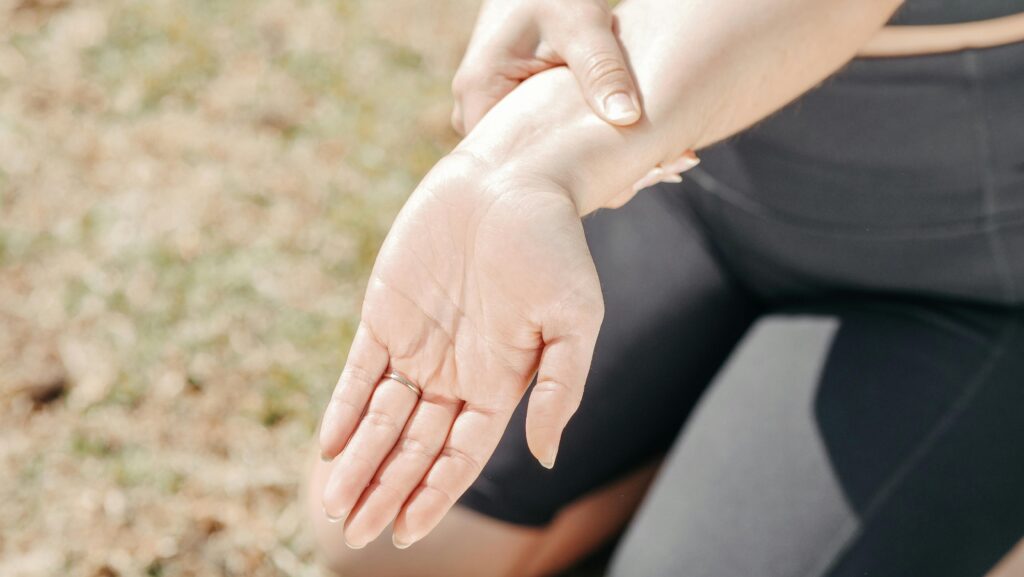
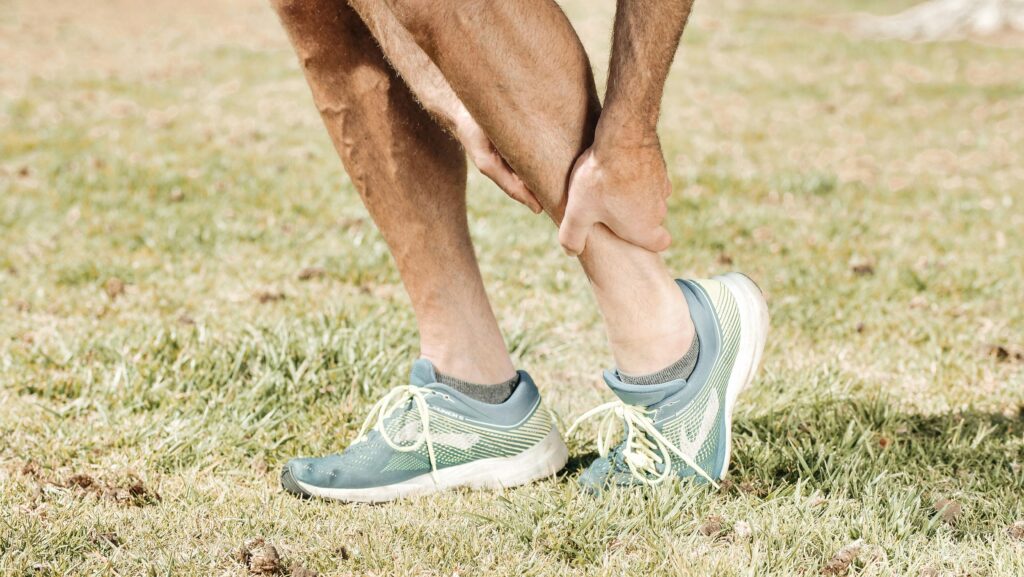
Similarly, extend your arms and make slow circles with your hands at the wrists, then perform flexion and extension movements. These improve blood flow and reduce wrist stiffness from computer use, preventing conditions like carpal tunnel syndrome. The cumulative effect of addressing every joint—from neck to ankles—creates systemic improvements in how your entire body moves and feels throughout each day.
How to Practice Safely: Frequency, Progressions and Common Mistakes
Joint mobility exercises carry minimal injury risk when performed correctly, but several common mistakes can reduce effectiveness or create problems. Understanding proper progressions and practice frequency ensures you gain maximum benefit while building sustainable habits that become lifelong practices rather than abandoned New Year’s resolutions.
Frequency and Timing: Practice joint mobility exercises daily, preferably in the morning to lubricate joints and wake up your nervous system before demanding activities. Unlike heavy strength training requiring recovery days, mobility work facilitates recovery rather than requiring it. Many practitioners find splitting practice into multiple short sessions throughout the day—5 minutes morning, 5 minutes midday, 5 minutes evening—more sustainable than single longer sessions.
The best time to train for flexibility is when your body feels slightly warm; light movement or warm shower beforehand enhances results. However, never force joints to painful extremes—mobility training should feel like exploring comfortable edges, not breaking through barriers. Reduces stiffness and improves posture occur progressively over weeks, not overnight, so patience and consistency matter more than intensity.
Common Mistakes to Avoid: The most frequent error involves moving too quickly, using momentum rather than muscular control. Each joint mobility exercise should be performed deliberately with full attention to the sensations and muscular engagement involved. Second, many people hold their breath during movement; continuous breathing actually facilitates greater range by preventing protective tension. Third, practicing only the exercises that already feel easy while avoiding challenging movements perpetuates existing limitations. The joints that feel stiffest need the most attention, though approached gradually with reduced ranges initially.
Fourth, expecting mobility training to replace strengthening exercises entirely—they’re complementary practices that enhance each other. Mobility without strength creates instability; strength without mobility creates rigidity. Finally, comparing your range of motion to others rather than tracking your own progress creates discouragement. Your body’s history, structure, and current condition are unique; improvement relative to your starting point is the only meaningful measure. Can mobility training replace stretching? Not entirely—both have value, but mobility training provides superior functional benefits because it develops control alongside flexibility rather than passive elongation alone.
Build Your Perfect Daily Joint Mobility Routine
Creating a sustainable daily practice requires balancing comprehensiveness with practicality. The following routine addresses all major joints in approximately 10-15 minutes, making it realistic to maintain indefinitely rather than temporarily before life’s demands crowd it out.
Morning Mobility Sequence: Begin standing with neck movements—10 forward/back movements, 10 side-to-side slides, then 5 slow circles each direction. Progress to shoulder rolls (10 each direction) followed by arm circles (8 forward, 8 backward). Perform thoracic twists (6 each side) then transition to the pelvic shift exercise (1-2 minutes). Execute hip circles (8 each direction, both sides) and leg swings (10 forward/back, 10 lateral, each leg). Practice the deep squat hold for 30-60 seconds.
Conclude with ankle circles (8 each direction, both feet) and wrist rolls. This comprehensive sequence systematically moves every major joint, increasing circulation throughout your body and establishing neuromuscular communication that enhances all subsequent movement throughout your day.
Midday Reset: During work breaks, focus on areas that accumulate the most tension from your specific activities. Office workers should emphasize neck, shoulder, and wrist movements. Manual laborers benefit from focusing on lower back, hip, and ankle mobility. Even 3-5 minutes of targeted joint mobility exercises significantly reduces accumulated stiffness and prevents the progressive tightening that eventually causes pain. Increases circulation to tissues that have remained static, bringing fresh oxygen and nutrients while clearing metabolic waste products. This brief intervention also provides mental break that enhances afternoon focus and productivity—your brain benefits from the movement as much as your body does.
Evening Wind-Down: Perform a slower, more meditative version of your morning sequence, holding positions slightly longer and focusing on releasing accumulated tension. This practice signals your nervous system that the active day has concluded, facilitating transition toward restorative sleep. Many people discover that evening mobility work dramatically improves sleep quality because it addresses physical discomfort that might otherwise cause nighttime awakening.
The key to sustainability lies in making the practice non-negotiable—as essential as brushing teeth—while remaining flexible about duration. Even two minutes of focused mobility work provides substantial benefit compared to zero minutes. As functional flexibility exercises become habitual, you’ll naturally expand practice because the immediate benefits create intrinsic motivation. You’re not sacrificing time to mobility training; you’re investing minutes that return hours of improved function and comfort throughout each day.
Conclusion: Move Freely, Live Fully
Joint mobility exercises represent perhaps the highest-return investment you can make in your physical wellbeing. The fifteen minutes daily you dedicate to systematically moving every major joint through its natural range repays you with hours of pain-free movement, reduced injury risk, enhanced athletic performance, and the preserved independence that makes life enjoyable at every age. Unlike equipment-dependent training requiring gym access or weather-dependent activities requiring specific conditions, mobility work requires only your body and minimal space—making consistency achievable regardless of circumstances.
The compound benefits extend far beyond the physical into psychological and emotional domains. When your body moves fluidly without restriction, you feel more confident, more capable, more willing to engage with life’s opportunities. The mind-body connection works both directions—physical freedom enhances mental freedom.
Start today with just the neck and shoulder exercises, or the pelvic shift, or the deep squat hold. Begin wherever you are, with whatever time you have. Your body possesses remarkable capacity to restore lost mobility when given appropriate attention, and that restoration begins with your very first conscious movement. Your future self—the one who climbs stairs without hesitation, plays actively with grandchildren, and moves through life without chronic pain—will thank you for starting now.
👉 Discover more natural ways to enhance your movement and well-being at your complete exercise routine guide.
Frequently Asked Questions About Joint Mobility Training
How often should I do joint mobility exercises?
Practice joint mobility exercises daily for optimal results. Unlike heavy strength training requiring recovery days between sessions, mobility work actually facilitates recovery while preparing your body for subsequent activity. Most people find 10-15 minutes each morning provides the greatest benefit, though splitting practice into multiple 5-minute sessions throughout the day works equally well. Consistency matters far more than duration—brief daily practice outperforms occasional longer sessions.
Your joints require regular movement to maintain synovial fluid circulation and tissue elasticity; days without movement allow stiffness to return. If you experience unusual soreness, reduce intensity rather than skipping entirely, as gentle movement typically accelerates recovery better than complete rest.
Can mobility training replace stretching entirely?
Mobility training provides superior functional benefits compared to passive stretching because it develops neuromuscular control alongside flexibility. Traditional static stretching creates temporary looseness but doesn’t train your nervous system to access or stabilize increased ranges, meaning improvements disappear quickly without continued stretching. Joint mobility exercises train active control throughout full range of motion, creating sustainable improvements that persist into your daily movements.
However, both approaches have value—mobility training should form your foundation, with occasional static stretching potentially beneficial for specific tight areas. The key distinction: mobility builds capacity you can use independently, while passive flexibility requires external force or extreme positions rarely encountered in daily life.
Do joint mobility exercises help with arthritis and chronic stiffness?
Yes, regular joint mobility exercises significantly benefit people with arthritis and chronic stiffness, though modifications may be necessary based on individual conditions. Movement promotes synovial fluid circulation that lubricates cartilage and reduces inflammation, while controlled exercise strengthens stabilizing muscles that reduce stress on affected joints. Many arthritis sufferers discover that gentle daily mobility work reduces pain and improves function more effectively than remaining sedentary to “protect” joints—inactivity actually accelerates deterioration.
Start with reduced ranges and shorter durations, prioritizing control and comfort over achieving full range immediately. Consistency matters more than intensity. Always consult healthcare providers about your specific condition, but understand that appropriate movement generally helps rather than harms arthritic joints. The functional flexibility exercises described here can be scaled to any fitness level, making them accessible even for those with significant movement limitations.
